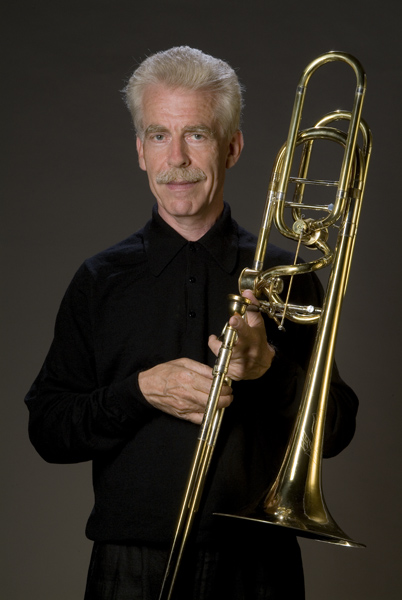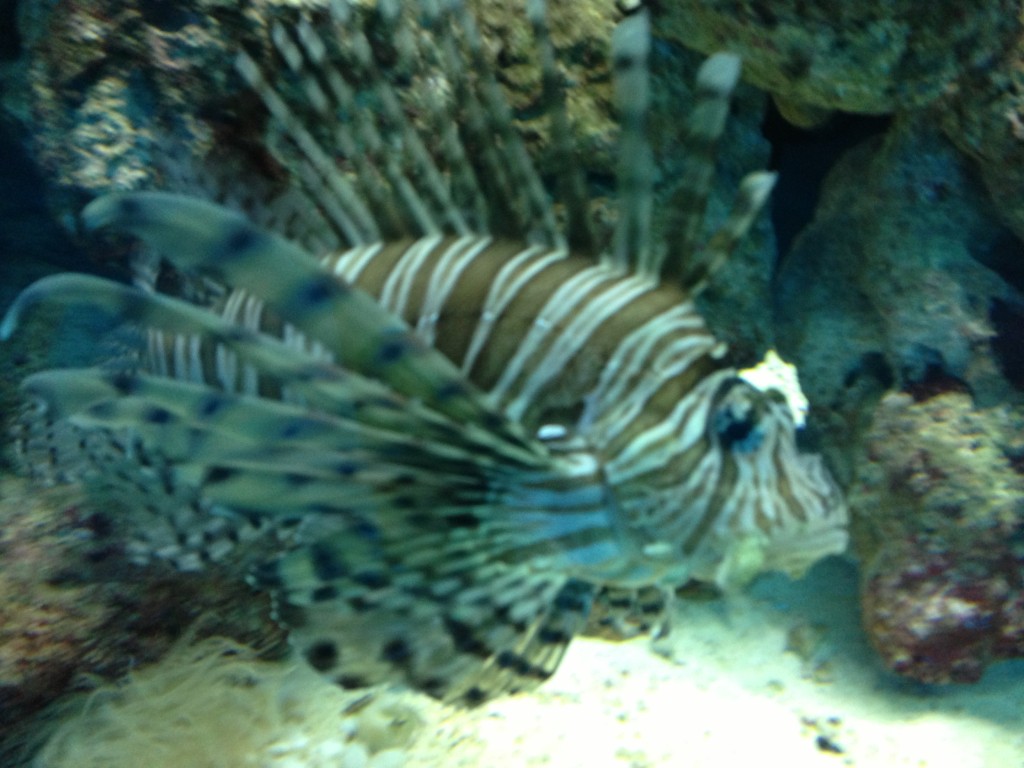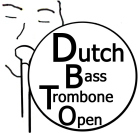Erik van Lier is one of Europe’s great bass trombonists, a thinking man’s musician, and a keen observer. A dynamo in his own right, he has accompanied some of the best jazz musicians in the world, and was a member of Slide Hampton’s storied European four trombone line-up. Erik van Lier is serving on the faculty of the 2014 Dutch Bass Trombone Open from September 5th through the 7th, and will provide his wealth of expertise and experience to those in attendance, in addition to presenting a workshop focusing on the bass trombone in a big band setting. davidbrubeck.com is privileged to present Mr. van Lier as the third respondent in our third series of “7 Positions” tm
 1. What do you look for in an instrument?
1. What do you look for in an instrument?
Since I mainly work in sections of 4 trombones, I like to have an instrument that can blend with jazz tenor trombones like the King 2B or 3B and Conn 6H. My idea is that the range of bass trombone parts can be divided in two functions. The bass function is roughly from B-flat on the second line of the staff downwards. Above that line, many times you don’t have a bass function. My experience has been that more than 50% of all the material that I have played in my life is above the B-flat on the second line. That part of my material would actually sound best when played on a tenor trombone! If I were to choose the biggest horn, with the darkest sound and the biggest mouthpiece my contribution to the section sound would be inadequate. Because of these realities, I think there should be some kind of compromise. A bass trombonist in a big band setting should be able to blend in both registers, below and above the B-flat that I mentioned.
For that reason, I think that the old Elkhart Conns-(71H, 72H or 73H), are the ideal horns. Compared to other bass bones, the bore of the tuning slide going into the bell is slightly smaller. That enables a compact sound that blends well with the tenor trombones, while retaining enough bass quality. I use 1 1/2G Bach mouthpiece. I think Bach mouthpieces sound the best, but unfortunately they are not consistent in quality. When subbing in a symphony orchestra, I used to play a Conn 63H with a red brass bell. It was a fantastic horn that blended well in that environment but, with the big band, I couldn’t use it because it doesn’t blend with the smaller jazz tenor trombones.
2. How do you conceive, describe or visualize the ideal tone quality?
I like to get a centered sound that blends with the tenors. I try to hear the pitch very well in order to get in the middle (center) of the note.
I want to hear the overtones. I want to make the sound rich by opening up the oral cavity, while staying compact in a relaxed embouchure. I compensate the opening up of the mouth cavity by applying more air volume.
I want to project my sound in order to reach the listener: like a teacher pointing out something on the blackboard with a long stick I want to touch people with my sound. With the richness and warmth that I try to achieve, I want to embrace the listener with my sound. Most importantly, I always want to make an emotional connection to whatever I am playing and that means that I am involved. This gives a different energy and therefore a different quality to the sound than just blowing air through the horn while holding the slide in a certain position and having no emotional connection to whatever you are playing. I want the sound to be soulful,
While trying to incorporate all these qualities and still keep my ears wide open to the lead trombone and the lead trumpet-in order to support them by blending and following their phrasing.
3. What is your secret to a good legato?
Dennis Wick said that you can play ‘forte’ while using a ‘piano’ tongue.
I try to minimize the tongue.The consequence is that the air has to function well.The most easy way for me is to have a musical image of a vocal style. The old ‘Belcanto’ school in singing is a good example-a centered, round, beautiful sound produced without any force in a fluent way. When you have that musical image of the ‘Belcanto’ style, and don’t think about the slide or the tongue at all, things will fall into place without you knowing how you did it.
 In addition, I like to avoid the clicks going from one overtone to another. I use glissando’s first to find the most efficient way to go from one note to the other, and then I try to use my embouchure in the same way when I make natural slurs. As a result, I try to use my embouchure in a (fast) glissando way which is similar to singing. When I go from F in the staff to G using 6th position to 4th, it could sound like ‘taahee’ whereas, going from 1 to 4 it could sound like ‘taalee’. To avoid this click (‘taalee’) I try to move fast in the (glissando) embouchure, and move late with the slide.
In addition, I like to avoid the clicks going from one overtone to another. I use glissando’s first to find the most efficient way to go from one note to the other, and then I try to use my embouchure in the same way when I make natural slurs. As a result, I try to use my embouchure in a (fast) glissando way which is similar to singing. When I go from F in the staff to G using 6th position to 4th, it could sound like ‘taahee’ whereas, going from 1 to 4 it could sound like ‘taalee’. To avoid this click (‘taalee’) I try to move fast in the (glissando) embouchure, and move late with the slide.
4. What helps you to achieve musical expression?
I like to play with authority. Authority in time and sound.
Since I want to be emotionally involved while playing, I try to adapt my personality to the character of the tune that I am playing. While playing a fast tune I will imagine myself as a bit of an uptight person who is perhaps also a bit aggressive. When I play a ballad, however, I will be mellow; I might imagine falling in love. Thad Jones wrote a tune with a nice title that reminds me how I should approach my musical language: ‘Mean What You Say’.

5. Name two types of inspiration: Musical & Non-musical
George Roberts is, of course, my musical inspiration number one.
Krishnamurti ,Karlfried Graf von Drckheim and Hazrath Inayat Kahn are people who inspire me on a spiritual level.
6. What are the one or two main points you learned from each of the following teachers: George Roberts, Ed Kleinhammer, Paul Falise, Alan Raph & Phil Teele?
George has, of course, this great sound. His style is coming from a musical approach, and this musical approach comes from singing Like a beautiful voice, it is focused, relaxed, round and flexible with a beautiful concept of sound. George Roberts possesses all of the qualities of the great singers of the Belcanto school.
Ed Kleinhammer has been a lifetime inspiration as well.
His dedication was always without any compromise; he was always there, always well prepared. Many times, Kleinhammer was the first one to warm up. All his life was dedicated to doing a great job in the orchestra, and his enthusiasm for music and playing the horn stayed till the very end.
Paul Faulise does a great job of playing the whole range in one embouchure setting with a very nice bass trombone sound. His kindhearted personality shows in his music. Paul gave me several good exercises to enable me to practice his approach.
Alan Raph did a great job designing the King 7bB by insisting on wide loops on the valve section and incorporating big valves. Alan advised me to open up a bit to improve the sound in the valve register.
Phil Teele told me that I had to pull in my cheeks a bit when playing the pedals, in order to keep the sound centered. That was simple, but very helpful advice.
 7. When playing really fast (‘prestissimo’) becomes necessary what percentage does each contribute to the equation; A good slide, A particular slide motion, Air, Articulations or Other Factors? What is your strategy?
7. When playing really fast (‘prestissimo’) becomes necessary what percentage does each contribute to the equation; A good slide, A particular slide motion, Air, Articulations or Other Factors? What is your strategy?
When I have difficult parts to play I will practice in steps:
i. I try to sing the notes so I will have a good idea of the intervals in a certain musical passage.
ii. When I know the music in that way I will look for different slide combinations and practice different options; just moving the slide without playing-(slowly, at first).
iii.When this is going without hesitation I try to combine the two.
iv. When the passage is really hectic I try to find out where are the important notes in the phrase and just play those in time, (leaving the unimportant notes out).
v. Then I try to sneak in, step by step, some of the less important notes while just staying focused on the timing of the important notes.
T1. What is the best trombone playing you have ever heard?
This is a difficult question to answer because there are so many great trombone players that do fantastic things.
However, if you were to ask me, “what is the trombone solo that moves you the most ?”, I would have an answer to that it is a trombone solo played by my good friend, Bobby Burgess, on ‘MacArthur Park’ with Woody Herman’s big band. Bobby plays the melody like a volcano, bubbling under the surface. First, in the lower octave, on his big Earl Williams trombone. There is much emotion that wants to come out. Then Bobby moves to the upper octave, and tells his story in a heartbreaking way. All of this is done with a fantastic sound, but most of all, Bobby is telling a story that moves me and that I believe in 100 %. There are no slick or artificial tricks; its very pure and honest music performed with a very high quality of trombone playing. Listen to the sound, to me, it’s unbelievable. Bobby once told me that they did 7 takes of the tune before everybody was satisfied, and that he started feeling better each track.
 T2. Describe your jazz soloing in big bands and small groups. How did you begin to solo, and what are your favorite recordings of your solos?
T2. Describe your jazz soloing in big bands and small groups. How did you begin to solo, and what are your favorite recordings of your solos?
I started playing professionally in the radio big band the Skymasters when I was 17. I never played any jazz solos. Then, Slide Hampton moved to Holland and formed a trombone quartet with my brother Bart, John English and myself with a rhythm section. Everybody was playing solos except for me. When some people asked me why I didn’t play solo, I gave them the stupid answer that “the bass trombone is not really suited so well for jazz solos”. But, after a while, I got fed up with this answer, and decided that it was time to give it a try.
The tune that I did play my first jazz solo was Donna Lee. I was 26 at the time. A favorite recording might be a solo that I did on First Brass; a recording with Bart, Alan Botschinsky and Derek Watkins; “Interlude No. 4”,played on my Miraphone ‘F’ tuba
T3. How did you play a key role in developing the tuning on the valves of the bass trombone?
In February 1969, I received a letter from Tony Studd-(a fantastic bass trombone player, listen to “Smackwater Jack” by Quincy Jones), about the Conn double-valve bass trombone that he was helping to design with Paul Faulise. He said that the ‘D’ horn was still a bit stuffy, and advised me to wait a bit until they were able to get some of the bugs out before buying a Conn double valve. As a matter of fact, when Conn brought it on the market, the horn had a very tight ‘D’ plug. The Conn people at that time didn’t seem to have any awareness of the advantage of an open wrap. Larry Minnick recognized the problem, and created an open wrap D plug that worked much better.
When I discovered that the configuration of the tubing could have an effect on the resistance in the valve register, I started thinking about another option to get a better low ‘B’, since I was not satisfied with the low ‘B’ I had on my horn. Going into the valve and out again causes the tubing to make two bends of 90 degrees. I reasoned that if I could make my second valve section very long, it would enable enable a low ‘B’ with just one valve, and I would have cut out at least two of these 90 degree corners.
I went to my repairman Ruud Pfeiffer, whose father was an instrument maker that had build French horns for the Residentie Orchestra of Den Haag. Ruud still had sketches from his old man showing a configuration of an open wrap similar to what is still used on German trombones. The tubing is also going forward, past the bell support, creating tubing that has roughly the shape of an 8 lying down sideways. Ruud did a fantastic job, and the result was a much better low ‘B’, because Ruud had eliminated (all together), 5 bends in the ‘D’ horn. As an extra bonus, there was a low B in first with two valves.
In 1974 I studied with Ed Kleinhammer, who was one of the forerunners in double valve design. He liked my instrument very much, and asked my permission to have a copy made by Shilke. Of course, I agreed. The disadvantage, however, of this double valve setup was that it effected the open horn in a negative way. As a result, I am very happy now to be using the Hagmann valves (not in-line).
For forty years, I have been using single tubing on the valve section (no tuning slides), which results in less weight and better resonance. When pulling out the valve section you will create a gap; the air passage becomes partly wider because of this pulling out and therefore there will be turbulence in the air column. You can avoid this turbulence by filling up the gap with tubing the same length of what you pull out. When you want to change your tubing to single tubing you only have to make sure that your first positions are high enough in pitch.
Final Thoughts
In order to improve as musicians we first have to become aware of the things that could benefit from a different approach. I have found that when we raise the level of awareness, we increase our chances to improve.
Many trombone players practice flexibilities without correcting the sharpness or flatness of some of the overtones. By doing so, bad habits are easily created and reinforced. By raising one’s awareness and listening carefully, one might find out that some notes are really out of tune. In turn, this could lead to adjustment of the positions, thus avoiding bad habits and creating better sounding notes. One would also become more familiar where to place these alternative positions.
My general advice to all musicians would be to raise the level of awareness in all the elements of their playing
c. 2014 David William Brubeck All Rights Reserved. davidbrubeck.com
PS
Dear Dave,
Please don’t hand in this information to the jazz police, otherwise I might be stopped at the border!
Interested in more “Seven Positions†tm Interviews?
Charlie Vernon
James Markey
Chris Brubeck
Doug Yeo
Jeremy Morrow
Tom Everett
Gerry Pagano
Ben van Dijk
Randall Hawes
Denson Paul Pollard
Thomas Matta
Fred Sturm
Bill Reichenbach
Massimo Pirone
Erik Van Lier
Jennifer Wharton
Matyas Veer
Stefan Schulz
c. 2013/2014 David William Brubeck All Rights Reserved davidbrubeck.com

